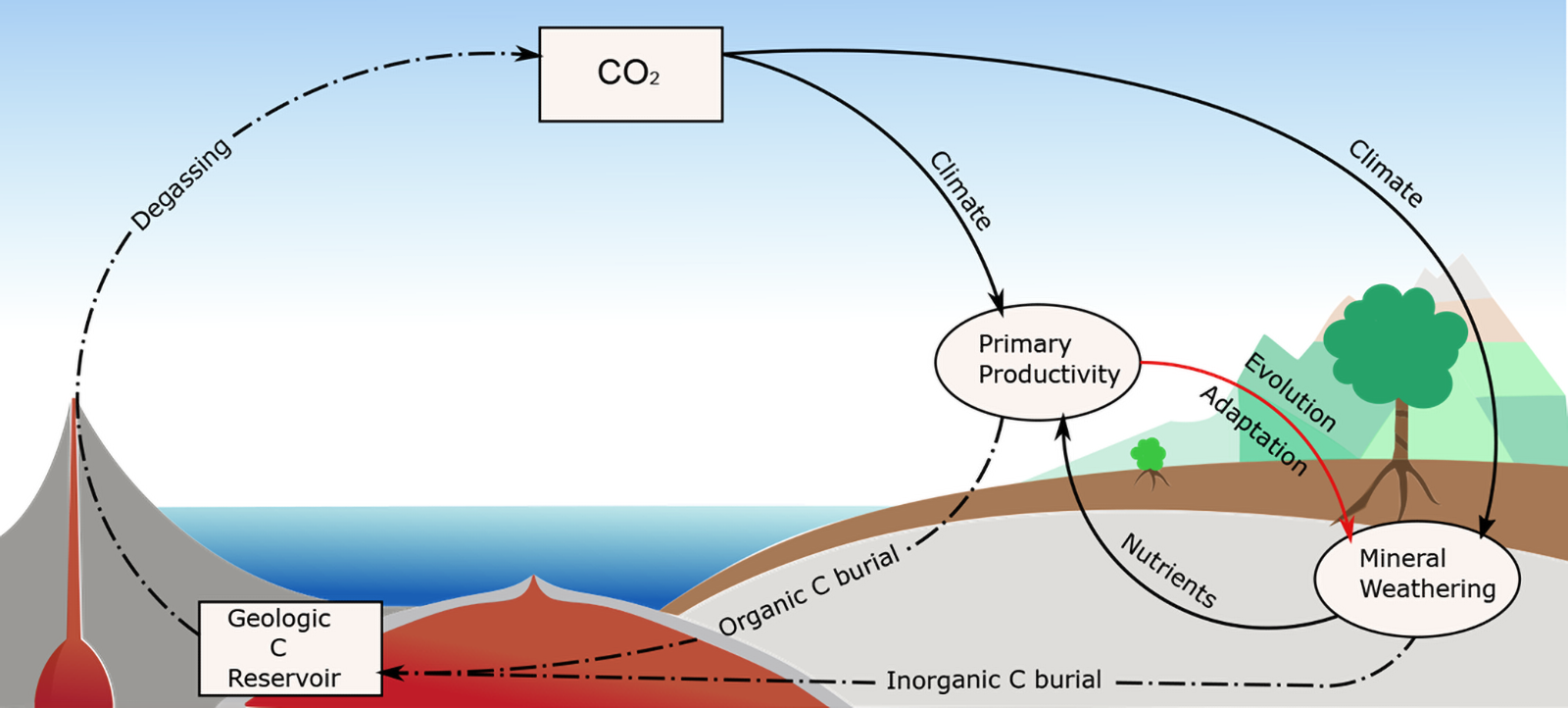4.30.24
Andrew Curry
In order to understand the Earth’s resilience, researchers at ETH Zurich are modelling climate changes from times long past. And they show: Plants are not simply victims of circumstances, but have helped to shape climate conditions on Earth.

Living fossils: 360 to 300 million years ago, tree-shaped ferns formed huge forests. Today they are mainly found in the humid tropics and subtropics. (Photograph: Adobe Stock)
_________________
In brief
-Researchers are using new computer models to simulate how climate change, continental drift and plant life have interacted over 390 million years of the Earth’s history.
-The simulation shows that plants not only passively participate in the climate cycle, but also play a significant role in shaping it.
-Long stable periods allow vegetation to flourish, absorbing CO2 and thus stabilising the Earth’s climate over time.
_________________
Over the course of hundreds of millions of years, Earth has lived through a series of climatic shifts, shaping the planet as we know it today. Past changes in CO2 levels and temperature can help us understand the planet‘s response to global warming today.
As part of a growing field called biogeodynamics, researchers are racing to understand how such changes have impacted life on the planet in the past. “We’re trying to understand processes relevant to the present using the geological past,” says Julian Rogger, who focuses on biogeodynamics at the Institute of Geophysics at ETH Zurich.
Rogger is fascinated by the interplay of plant life and climate. So far our planet is the only one we know of in the universe suited to support living organisms. Its climatic conditions allow for the presence of enough liquid water to enable plants and other complex organisms to thrive, or at least survive. When the planet’s climate shifts, it impacts plant life, forcing ecosystems to evolve and adapt to changing conditions. “I’m interested in the role of life itself in the whole system,” Rogger says. “I find it really fascinating to reconstruct the world as it was millions of years ago.”
Plants actively shape the climate cycle
In a paper published recently in the journal Science Advances, Rogger and colleagues from ETH and the University of Leeds argue that those plants aren’t just passive participants in Earth’s climate cycle – they can play an important role in shaping it. “We could assume life is just reacting to changes, but it’s also possible it’s interacting with the system and regulates it,” Rogger says.
To show how, Rogger used computer models that simulate the interplay between climate change, movement of the continents and plant life in the deep past. The models indicate plants probably help regulate the makeup of the planet’s atmosphere by trapping carbon and emitting oxygen, helping control CO2 levels. They also accelerate the process of mineral weathering in soils, a process that consumes CO2. Rogger’s models suggest the planet’s climate and atmosphere are part of a feedback loop: Life itself plays a role in regulating or accelerating climatic changes.
390 million years of Earth’s history reconstructed
When change is slow – slow enough for plants to evolve or spread to new niches over millions of years – plant activity can act as a buffer, preventing temperatures from shifting too rapidly. But geology and the fossil record show there were also changes that took place too fast, and resulted in major disruptions of vegetation and even mass extinctions. “What we want to know is how fast vegetation is able to change its characteristics when the world suddenly gets 5 or 6 degrees warmer,” Rogger says. “The overall goal is to understand the co-evolution of climate, vegetation and tectonics.”
Rogger and his co-authors – an interdisciplinary team of geologists, computer scientists and earth scientists– created a computer model of the last 390 million years that took into account the shifting of the continents and climate and the vegetation’s response to these changes. Running simulations on powerful supercomputers can still take up to a month, given the complexity of the problem and the length of time they are supposed to represent.
Whenever possible, the team uses geological data to make the models as realistic as possible: Chemical analysis of sediments, for example, can be an indicator for carbon dioxide levels in the past. Fossils can show when dramatic shifts in climate led to mass extinctions, or the evolution of new ecosystems in response to changing conditions.

Representation of long-term global carbon cycle. (from Rogger J et al. Science Advances 2024)
The models show that long periods of stability make it possible for vegetation to flourish, absorbing CO2 and stabilizing the Earth’s climate over time. In their models, the team saw that plants were able to evolve fast enough to adjust to gradual shifts in climate and landscapes due to continental drift, for example.
But when the climate system is disrupted and changes too rapidly for vegetation to adapt, the opposite happens: Plants are wiped out and can’t act as a buffer to slow down shifts in climate. Without plants to act as a brake, environmental changes happen even faster and push further towards the extreme. “It’s like a feedback effect,” Rogger explains. “Because regulation falls away, you could have a stronger increase in CO2 and more climate change than was previously expected.”
Resilience put to the test
In the geological record, abrupt climate changes are often accompanied by mass extinction events. “There are strong vegetation changes where it took thousands to millions of years for vegetation to adapt and recover,” Rogger says, “and what recovers can be very different than what was there before.”
That’s not good news. “The rate of change we have at the moment is thought to be unprecedented over the past 400 million years,” Rogger says. “There could be a reduction in the capacity of vegetation to regulate climate if there is a strong change, like we’re experiencing now.”
At a time when the Earth’s climate is changing faster than ever before, Rogger’s research has practical implications: Information from the past can help people today understand how resilient the Earth’s interlocking systems are. “How fast are ecosystems able to respond to changes in the climate and landscape? That’s one of the major unknowns,” he says. “It’s an acute question – how resilient is the Earth?”
See the full article here.
Comments are invited and will be appreciated, especially if the reader finds any errors which I can correct.
five-ways-keep-your-child-safe-school-shootings
Please help promote STEM in your local schools.
The Swiss Federal Institute of Technology in Zürich [ETH Zürich] [Eidgenössische Technische Hochschule Zürich] (CH) is a public research university in the city of Zürich, Switzerland. Founded by the Swiss Federal Government in 1854 with the stated mission to educate engineers and scientists, the school focuses exclusively on science, technology, engineering and mathematics. Like its sister institution The Swiss Federal Institute of Technology in Lausanne [EPFL-École Polytechnique Fédérale de Lausanne](CH) , it is part of The Swiss Federal Institutes of Technology Domain (ETH Domain)) , part of the The Swiss Federal Department of Economic Affairs, Education and Research [EAER][Eidgenössisches Departement für Wirtschaft, Bildung und Forschung] [Département fédéral de l’économie, de la formation et de la recherche] (CH).
The university is an attractive destination for international students thanks to low tuition fees of 809 ₣ per semester, PhD and graduate salaries that are amongst the world’s highest, and a world-class reputation in academia and industry. There are currently students from over 120 countries, many of which are pursuing doctoral degrees. In the QS World University Rankings ETH Zürich is ranked very highly in the world and very highly by the Times Higher Education World Rankings. In the QS World University Rankings by subject it is ranked very highly in the world for engineering and technology, earth & marine science.
Nobel laureates, Fields Medalists, Pritzker Prize winners, and Turing Award winners have been affiliated with the Institute, including Albert Einstein. Other notable alumni include John von Neumann and Santiago Calatrava. It is a founding member of the IDEA League and the International Alliance of Research Universities (IARU) and a member of the CESAER network.
ETH Zürich was founded on 7 February 1854 by the Swiss Confederation and began giving its first lectures on 16 October 1855 as a polytechnic institute (eidgenössische polytechnische schule) at various sites throughout the city of Zurich. It was initially composed of six faculties: architecture, civil engineering, mechanical engineering, chemistry, forestry, and an integrated department for the fields of mathematics, natural sciences, literature, and social and political sciences.
It is locally still known as Polytechnikum, or simply as Poly, derived from the original name eidgenössische polytechnische schule, which translates to “federal polytechnic school”.
ETH Zürich is a federal institute (i.e., under direct administration by the Swiss government), whereas The University of Zürich [Universität Zürich ] (CH) is a cantonal institution. The decision for a new federal university was heavily disputed at the time; the liberals pressed for a “federal university”, while the conservative forces wanted all universities to remain under cantonal control, worried that the liberals would gain more political power than they already had. In the beginning, both universities were co-located in the buildings of the University of Zürich.
From 1905 to 1908, under the presidency of Jérôme Franel, the course program of ETH Zürich was restructured to that of a real university and ETH Zürich was granted the right to award doctorates. In 1909 the first doctorates were awarded. In 1911, it was given its current name, Eidgenössische Technische Hochschule. In 1924, another reorganization structured the university in 12 departments. However, it now has 16 departments.
ETH Zürich, EPFL (Swiss Federal Institute of Technology in Lausanne) [École polytechnique fédérale de Lausanne](CH), and four associated research institutes form The Domain of the Swiss Federal Institutes of Technology (ETH Domain) [ETH-Bereich; Domaine des Écoles polytechniques fédérales] (CH) with the aim of collaborating on scientific projects.
Reputation and ranking
ETH Zürich is ranked among the top universities in the world. Typically, popular rankings place the institution as one of the best universities in continental Europe and ETH Zürich is consistently ranked among the top universities in Europe, and among the best universities of the world.
Historically, ETH Zürich has achieved its reputation particularly in the fields of chemistry, mathematics and physics. Nobel laureates are associated with ETH Zürich, the most recent of whom is Richard F. Heck, awarded the Nobel Prize in chemistry in 2010. Albert Einstein is perhaps its most famous alumnus.
The QS World University Rankings placed ETH Zürich very high in the world. ETH Zürich has ranked very highly in the world in Engineering, Science and Technology, just behind The Massachusetts Institute of Technology, Stanford University and The University of Cambridge (UK). ETH Zürich also ranked very highly in the world in Natural Sciences, and in Earth & Marine Sciences.
The Times Higher Education World University Rankings has ranked ETH Zürich very highly in the world in the field of Engineering & Technology, just behind
The Massachusetts Institute of Technology, Stanford University, The California Institute of Technology, Princeton University, The University of Cambridge (UK),
Imperial College London (UK) and
The University of Oxford (UK).
In a comparison of Swiss universities by swissUP Ranking and in rankings published by CHE comparing the universities of German-speaking countries, ETH Zürich traditionally is ranked very highly in natural sciences, computer science and engineering sciences.
In the survey CHE Excellence Ranking on the quality of Western European graduate school programs in the fields of biology, chemistry, physics and mathematics, ETH Zürich was assessed as one of the institutions to have excellent programs in all the considered fields, the other two being Imperial College London (UK) and the University of Cambridge (UK), respectively.


